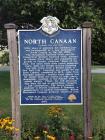Inscription
mountain laurel blooms." - WILBUR L. CROSS
North Canaan was once part of the Town of Canaan, established in 1738. Settlers, whose families were of Dutch and English origin, had to be self-sufficient, looking to their own farms for necessities. There was early interest in smelting and forging iron at sites along the Blackberry (Bromfoxit) River, which powered the blast at Beckley Furnace, still standing. Needed resources were at hand - ore from nearby Salisbury, limestone, and charcoal - so that for nearly two hundred years it was practical to produce pig iron and items ranging from nails to ship anchors. At a short distance stands Lawrence Tavern, built in 1751 and still owned by descendants of the original family. Settlements in Canaan Valley and East Canaan were separated by Canaan Mountain from the more populous southern part of the township.
< Reverse Side: >
Details
| HM Number | HMPCJ |
|---|---|
| Tags | |
| Year Placed | 1978 |
| Placed By | Town of North Canaan, Falls Village - Canaan Historical Society and Connecticut Historical Commission |
| Marker Condition |           3 out of 10 (2 reports) |
| Date Added | Tuesday, October 14th, 2014 at 1:21pm PDT -07:00 |
Pictures
Locationbig map
| UTM (WGS84 Datum) | 18T E 638584 N 4653883 |
|---|---|
| Decimal Degrees | 42.02478333, -73.32600000 |
| Degrees and Decimal Minutes | N 42° 1.487', W 73° 19.56' |
| Degrees, Minutes and Seconds | 42° 1' 29.22" N, 73° 19' 33.60" W |
| Driving Directions | Google Maps |
| Area Code(s) | 860 |
| Closest Postal Address | At or near 4 Main St, Canaan CT 06018, US |
| Alternative Maps | Google Maps, MapQuest, Bing Maps, Yahoo Maps, MSR Maps, OpenCycleMap, MyTopo Maps, OpenStreetMap |
Is this marker missing? Are the coordinates wrong? Do you have additional information that you would like to share with us? If so, check in.
Nearby Markersshow on map
Show me all markers in: Canaan, CT | Litchfield County | 06018 | Connecticut | United States of America
Maintenance Issues
- Is this marker part of a series?
- What historical period does the marker represent?
- What historical place does the marker represent?
- What type of marker is it?
- What class is the marker?
- What style is the marker?
- Does the marker have a number?
- This marker could use another picture or two.
- Can this marker be seen from the road?
- Is the marker in the median?


Comments 0 comments